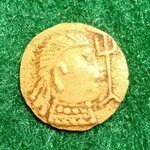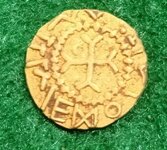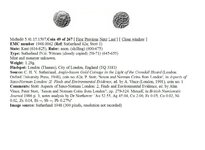mudslideslim
Sr. Member
- Mar 21, 2006
- 295
- 24
- Detector(s) used
- Minelab CTX 3030, Deus
- Primary Interest:
- All Treasure Hunting
Here are a couple of field pics of my coin moments after I dug it in England last week. As you can see it came out of the ground beautiful - just a little dirt. That's gold for you - doesnt matter how old it is. Here are the particulars: English Saxon Thrysmas gold coin - Crondall type c620 -650 AD -named after the hoard found in 1828. Sent off to the Fitzmuseum Corpus database for recording 1.26g, 11.46mm - 'Witmen type'
Click on the link below to check out the full length movie put together by the outfitter we used in England. It consists of videos I shot with the hatcam, mixed in with some great hunt footage he took along with some still shots with other finds. Enjoy!
hh
slim
Click here to view the video! http://www.colchestertreasurehunting.co.uk/thisweekfindsquick.htm
(scroll down till you see the VIDEO DOWNLOAD PAGE link.)
Click on the link below to check out the full length movie put together by the outfitter we used in England. It consists of videos I shot with the hatcam, mixed in with some great hunt footage he took along with some still shots with other finds. Enjoy!
hh
slim
Click here to view the video! http://www.colchestertreasurehunting.co.uk/thisweekfindsquick.htm
(scroll down till you see the VIDEO DOWNLOAD PAGE link.)
Attachments
Upvote
1






 They have to prove it is a one off which this ain't
They have to prove it is a one off which this ain't



